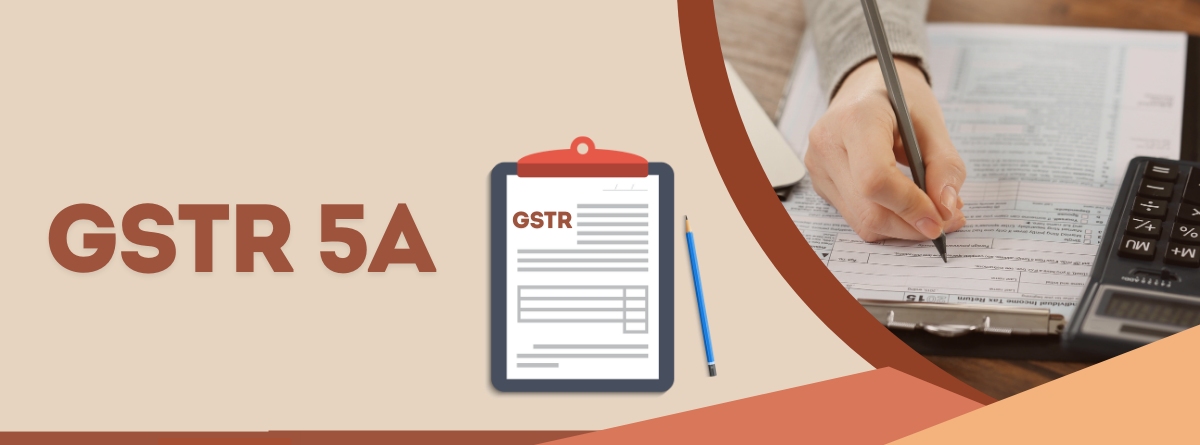Content
Resident OIDAR Service Providers
Today, businesses are no longer confined by geographical boundaries. The internet provides services across borders, and one such avenue is through Online Information and Database Access or Retrieval (OIDAR) services. As the Indian economy adapts to this technological shift, the Goods and Services Tax (GST) regime has introduced a specific return, GSTR-5A, to ensure compliance and facilitate seamless taxation for non-resident OIDAR service providers operating in India.
Unlock the full article - sign in with Gmail!
Expand Your Market Knowledge with 5paisa Articles
What Is GSTR-5A?
GSTR-5A is a monthly return that must be filed by non-resident Online Information and Database Access or Retrieval (OIDAR) service providers who offer their services to unregistered individuals or customers in India. These services are typically provided through the internet, without any physical interface between the service provider and the recipient.
OIDAR services encompass various offerings, such as cloud-based solutions, online data storage and retrieval, online advertising services, and more. The primary objective of introducing GSTR-5A is to ensure a level playing field for domestic service providers by subjecting these non-resident OIDAR services to GST taxation.
Who Needs To File GSTR-5A?
GSTR-5A is a mandatory filing for non-resident OIDAR service providers who cater to unregistered individuals, government entities, or local authorities in India. It is important to note that if the services are provided to a registered person or entity, the GST liability falls under the reverse charge mechanism, where the recipient is responsible for paying the tax.
However, when the services are offered to unregistered individuals or entities for purposes other than business or commerce, the non-resident OIDAR service provider is responsible for GST payment, necessitating the filing of GSTR-5A.
Key Components Of GSTR-5A
GSTR-5A is a comprehensive return that captures various aspects of the OIDAR services provided by non-resident entities. The key components include:
● Taxable outward supplies: This section requires the service provider to furnish details of taxable outward supplies made to consumers in India, including the place of supply, tax rate, taxable value, integrated tax, and cess.
● Amendments: Any amendments or corrections to the taxable outward supplies made to non-taxable persons in India during previous tax periods must be reported in this section.
● Interest and other amounts: This section allows the service provider to calculate and report any interest or other amounts, such as penalties or arrears, that may be applicable.
● Tax, interest, and other amounts payable and paid: This section summarises the total tax liability, interest, late fees, and any other amounts paid by the service provider.
Due Date For Filing GSTR-5A
The due date for filing GSTR-5A is the 20th day of the month following the tax period for which the return pertains. For example, the May 2024 GSTR-5A must be filed by June 20th, 2024. However, it is important to note that the Commissioner may extend this due date in certain circumstances.
Documentation Required For GSTR-5A
To file GSTR-5A accurately, non-resident OIDAR service providers must maintain proper documentation and records. The primary requirements include:
● Valid Goods and Services Tax Identification Number (GSTIN)
● User ID and password for accessing the GST Portal
● Non-expired and non-revoked PAN-based Digital Signature Certificate (DSC) for filing with DSC (if applicable)
Filing Procedure For GSTR-5A
The filing procedure for GSTR-5A involves several steps, which can be summarised as follows:
Step 1: Log in to the GST Portal using valid credentials.
Step 2: Navigate to the "Returns" section and select "File Returns."
Step 3: Choose the relevant financial year and tax period for which the return needs to be filed.
Step 4: In the GSTR-5A tile, click the "Prepare Online" button.
Step 5: Enter the details of taxable outward supplies made to consumers in India, including the place of supply, tax rate, taxable value, integrated tax, and cess.
Step 6: Provide details of any amendments to taxable outward supplies made to non-taxable persons in India for previous tax periods.
Step 7: Calculate and enter any interest or other amounts, such as penalties or arrears.
Step 8: Review the tax, interest, and other amounts payable and paid.
Step 9: Preview the draft GSTR-5A in PDF format and make necessary corrections, if any.
Step 10: Initiate filing by clicking the "Proceed to File" button and ensuring sufficient balance in the Electronic Cash Ledger.
Step 11: Select the "Declaration" checkbox and choose the authorised signatory from the dropdown list.
Step 12: File GSTR-5A using either a Digital Signature Certificate (DSC) or an Electronic Verification Code (EVC).
Step 13: Upon successful filing, an acknowledgement will be generated, and a confirmation email and SMS will be sent to the authorised signatory.
Late Fees And Penalties In Filing GSTR 5A
Timely filing of GSTR-5A is crucial to avoid any late fees or penalties. If there is a delay in filing the return, the following late fees may be applicable:
- For a normal return (with taxable supplies): ₹200 per day
- For a nil return (no taxable supplies): ₹100 per day
It is essential to adhere to the due dates and ensure accurate and timely filing of GSTR-5A to maintain compliance with the GST regulations.
Conclusion
GSTR-5A ensures GST compliance for non-resident OIDAR service providers operating in India. By filing this return, these service providers can accurately report their taxable outward supplies, amendments, and additional liabilities, promoting transparency and facilitating seamless taxation in the digital services sector. Adhering to the filing procedure, maintaining proper documentation, and understanding the applicable late fees and penalties are crucial for non-resident OIDAR service providers to remain compliant with the GST regime.



